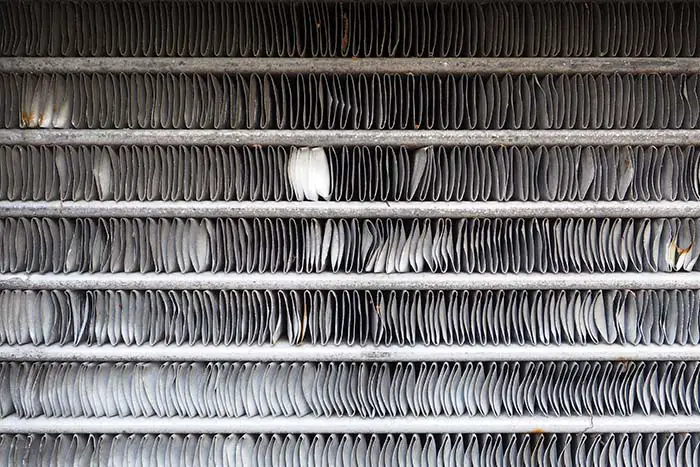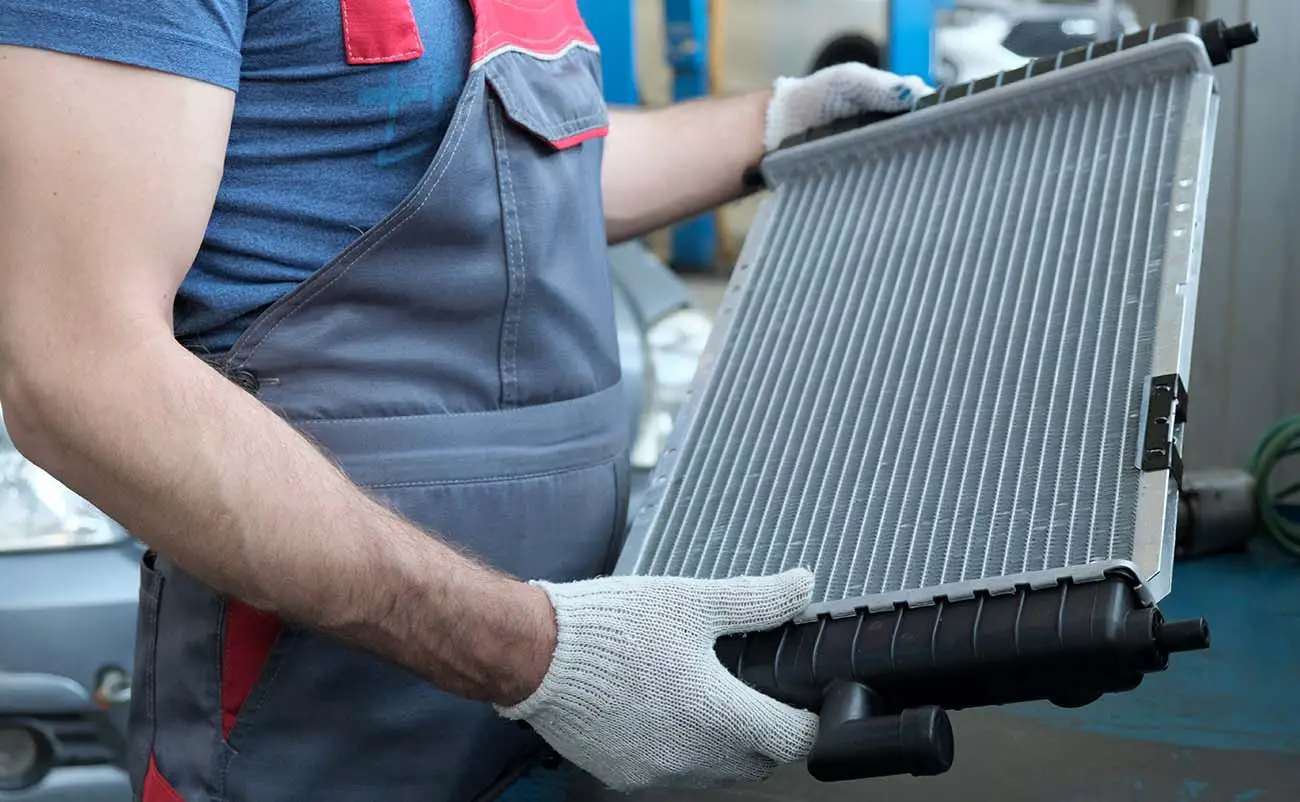Your radiator is a critical piece of your car’s cooling system. Without a properly functioning radiator, your car’s engine would overheat quickly. Overheating can lead to extensive engine damage, which means a huge repair bill. That is why it’s vitally important to make any necessary radiator repairs as soon as possible. Allowing coolant to leak out of your radiator for too long will lead to low coolant levels and much bigger problems. Thankfully, radiator repairs are not always extremely complex and expensive. Keep reading as we tell you everything you need to know about how your radiator works, how to tell when it has a problem, and how you can fix it!
Table of Contents
How Does A Car Radiator Work?
To fully understand how a car radiator works, you need to have a general idea of how your car’s overall cooling system works. Let’s start with a general overview of the cooling system, and then we will get into specific details of how the radiator fits into the system. First, coolant is circulated through small passages in your engine block and cylinder heads by the engine’s water pump. As the coolant circulates, it removes heat from the engine. Once it passes through the engine, it is either recirculated through the engine or pumped to the radiator through the radiator hoses, depending on whether the car’s thermostat is open. The radiator then removes the heat from the coolant, and the cooled coolant is then pumped back into the engine to start the process over again.
As coolant is pumped through the radiator, it passes through passages inside the radiator. The radiator is covered in small metal fins, which act as great conductors for the heat inside the coolant. As air blows across the radiator fins, either due to the speed your vehicle is traveling or the cooling fans turning on, the heat is quickly removed from the coolant. The coolant then returns to nearly the ambient air temperature. The heat exits the radiator quickly via the metal fins, and the coolant makes a return trip to the car engine to keep the vehicle’s engine cool.
Signs Of A Bad Radiator

So, how can you tell if your radiator is having trouble? There are several signs that you can watch for that might signal problems with your radiator. Here are the most common symptoms that you will likely run across.
— Engine Overheating
An overheating engine is almost always a telltale sign of a bad radiator. Since the radiator plays such a crucial role in removing heat from the engine, a bad radiator will quickly lead to a high engine temperature. If you notice that the car’s coolant system is allowing the engine’s temperature to get too high, then you should have a repair shop check out your radiator. While overheating can be caused by other issues, like a bad thermostat or blown head gasket, the radiator is the most likely culprit. Get this checked right away, as allowing your car to overheat can lead to catastrophic damage, like a cracked engine block.
— Leaking Coolant
A radiator leak is a definite sign that you are due for an automotive repair. If you notice antifreeze leaking from your radiator, then you definitely have a problem and will want to get it addressed right away. If you notice a green or pink puddle under your car, then you can do a little searching to find the cause. It could be from a radiator leak, but it could also be a cracked hose or a bad water pump. Either way, you will want to get the problem corrected as it is not safe to drive with a coolant leak.
— White Smoke Or Steam From Engine Bay
If you see steam or white smoke coming from under your hood, there is a good chance you have a radiator problem. It’s possible that a hose has burst and is allowing hot coolant to spill out onto your engine. This creates a cloud of white smoke and steam billowing out of your engine bay. You might also have a failing radiator cap that is causing steam to escape. Whatever the cause, you will need a repair service soon. This is not something you should ignore, and you should stop driving your vehicle right away if you see steam and smoke rising from under the hood. Continuing to drive it in this condition can result in extensive damage.
— Sweet Smell
Engine coolant has a distinct sweet smell that many people can recognize right away. If you notice a sweet smell when standing near your vehicle, a bad radiator could be the cause. Leaking coolant allows the smell of the coolant to waft from the engine bay or from underneath the vehicle. Upon noticing this smell, look for any drips or puddles under your car. Open up the hood and look for leaking coolant. You will want to head to your local auto repair shop soon to get the problem corrected.
How To Perform A Radiator Repair
The steps needed to repair your radiator depends on the problem you need to correct. Performing the proper diagnostics up front is important to fix the root of the issue. In some cases, you might simply need a new radiator cap. However, this is usually not the case. A radiator flush can take care of your problem in many cases. Corrosion and other contaminants can block the passages in your radiator and prevent it from properly removing heat from your coolant. In that case, you can flush your vehicle’s radiator with a special flush treatment to remove buildup and debris. This will often get your vehicle’s cooling system working properly again.
If your radiator is leaking, it can sometimes be repaired by pouring in a bottle of radiator sealant and allowing it to circulate through the system. Some radiator repair services can even patch or weld radiators to stop leaks. Welding a radiator can be a tedious task that requires an expert skill level, and this is not always an option.
In many cases, a complete radiator replacement is needed. Thankfully, this is not an overly complex car repair on most vehicles. Replacing a radiator involves draining the old coolant from the system, disconnecting the radiator hoses, unbolting and removing the old radiator, installing the new radiator, reconnecting the hoses, and filling the system with radiator coolant. The entire job usually takes less than a couple of hours in most cases. It is also crucial to perform regular maintenance services on your cooling system to help extend the life of your car’s radiator!
While not necessary as often as an oil change or tire rotation, a coolant flush should be performed every 30,000 to 50,000 miles. Over time, coolant becomes acidic and starts to corrode your radiator and other internal parts of the cooling system. In addition, the coolant starts to lose its cooling ability over time. Replacing the old coolant with new coolant helps keep the system operating correctly, and it will keep your radiator working properly for years to come.
Average Cost Of Radiator Repairs
The cost of your radiator repair will vary greatly depending on the type of repair needed. Unlike some auto repair services, radiator repair can be a small or more complex job. If your radiator simply needs a coolant flush, then you can expect the job to cost between $200 to $400 in most cases. This job will usually take a mechanic about an hour, and it will require a few gallons of coolant mixture.
When it comes to repairing or replacing a radiator, the cost will increase. Repairing a radiator can cost you anywhere from $300 to $800. This type of repair generally requires the removal of the old radiator, which adds more labor costs to the bill. A complete radiator replacement is usually the most expensive type of repair. You can expect the new radiator to cost anywhere from $200 to $500, and the job usually requires a couple of hours of labor. A complete radiator replacement can cost anywhere from $400 to $1,000. Most shops include a limited warranty as part of this repair cost. Since replacing a radiator is not cheap, you can see now why it is so essential to perform proper maintenance on your car’s radiator and cooling system.
The Bottom Line
If your engine is overheating, the chances are high that you need a radiator repair. Radiator repairs can come in many forms, from a simple coolant flush to a total radiator replacement. Sometimes, your repair bill could exceed $1,000 for a replacement. Keep an eye on the warning signs from your vehicle, like your temperature gauge getting too high or a sweet smell under your hood. If you notice any of these issues, have a mechanic look at your radiator immediately. Waiting too long could lead to other problems and cause serious damage to your vehicle.
Frequently Asked Questions
Can a damaged radiator be repaired?
In some cases, a damaged radiator can be repaired. Whether or not a repair is successful often depends on the extent of the damage. If there is a very small hole or crack in the radiator, a repair will often fix it. However, if the damage is larger or more widespread, then a repair attempt will usually fail. In that case, a radiator replacement will be necessary. An experienced mechanic will be able to advise you whether or not a repair should be attempted.
Is it worth fixing a radiator?
If your radiator is in otherwise good shape except for a small bit of damage, it is usually worth fixing it. However, if the radiator is several years old and is already corroded internally, then you should not attempt to repair it. The better option is to replace it with a new radiator. Repairing an old radiator with multiple problems is usually not worth it. Even if the repair is successful, it is not likely to last very long anyway.
What is the best way to fix a radiator?
One of the easiest ways to fix a radiator is by using a radiator sealant. This type of sealant can be poured into the radiator and allowed to circulate through the cooling system. This product can seal internal leaks within the radiator, and it is very easy to use. Skilled mechanics can often weld a small crack or leak in a radiator as well. However, if the crack is too large, welding will usually not be an option. If a radiator cannot be repaired, then a replacement will be needed.
How long does a radiator repair take?
The length of time required to fix a radiator depends on the type of repair being performed. In most cases, a radiator repair only takes a few hours from start to finish. This includes the time required to remove and reinstall the radiator. If a sealant is used, it might need time to dry before adding coolant back into the system. However, the majority of radiator repairs can be completed in less than a day.

